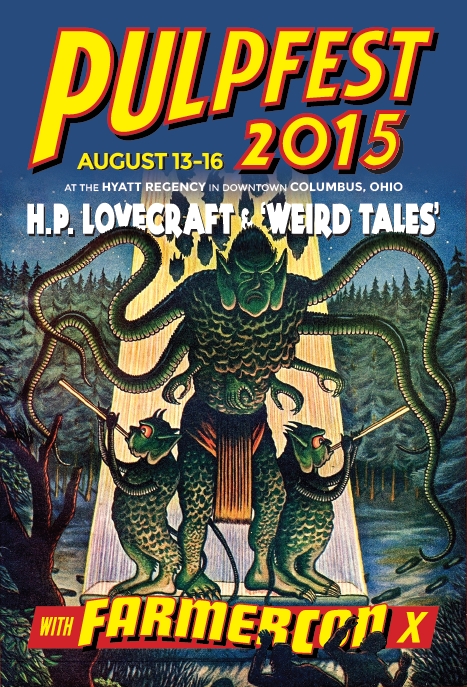“The twentieth century’s greatest practitioner of the classic horror tale” — Stephen King
“The Copernicus of the horror story” — Fritz Leiber
“To me, Howard Phillips Lovecraft was an entity. A most important one. And I rejoice to see that his work–and his memory among readers and writers–endures” — Robert Bloch
In his introduction to THE BEST OF H. P. LOVECRAFT: BLOODCURDLING TALES OF HORROR AND THE MACABRE (Del Rey Books, 1982), Robert Bloch remembers the man who, “. . . befriended a fifteen-year-old fan, who gave him a lifelong career, who set an example of fellowship and good-will . . .”
Howard Phillips Lovecraft was born in Providence, Rhode Island on August 20, 1880. He was the last lineal descendant of an old New England family that had seen better days. His father died of paresis in 1898; his mother survived until 1921, but her own mental instability increased as the family fortunes declined.
Lovecraft wrote: “As a child I was very peculiar and sensitive, always preferring the society of grown persons to that of other children.” Actually it was his neurotic mother who labelled him peculiar and “protected” him from contact with other youngsters. A precocious child, he learned to read when he was four and soon experimented with writing. Poor health kept him from college and economic necessity eventually caused him to neglect amateur journalism in favor of ghostwriting or revising the work of others for professional publication. Gradually he began to produce poetry and fiction of his own.
After his mother’s death he lived for a time in New York, married an older woman from whom he separated amicably two years later, then returned to Providence. Here he made his home with two elderly aunts. One of them died in 1932; he and his surviving relative resided together until his own death on March 15, 1937.
Lovecraft’s career as a professional writer was largely compressed into a span of about sixteen years. He remained virtually unknown except to the limited readership of pulp magazines such as WEIRD TALES in which his work appeared. It earned only a pitiful pittance to supplement the income from a meager inheritance, and he continued his anonymous chores for other writers. At the same time he brightened and broadened his uneventful existence with a widespread correspondence among fellow writers and readers of fantastic fiction. The most constant and devoted members of this group formed what would later be called “the Lovecraft Circle”; his lengthy letters of comment, criticism, and literary advice encouraged them to write or attempt writing in the genre. When a combination of cancer and Bright’s disease claimed his life at the age of forty-six the loss was mourned by far-off friends, many of whom had known him only as a correspondent.
Lovecraft’s literary style was distinctive and frequently imitated by protégés. With his approval, they and others borrowed the imaginary settings of his stories, together with the weird books and grotesque gods he created to heighten horror.
At the time of his death he had already become what would now be called a “cult figure.” But the cult was comparatively small and had absolutely no influence on contemporary critics or publishers. It took long years to bring the man and his work to the attention of a larger audience.
Today Lovecraft is established as a major American fantasy writer, frequently ranked as the equal of Poe. His work is in print here and abroad and the mild-mannered, old-fashioned, conservative New England gentleman has become an acknowledged master of horror fiction.
Join PulpFest 2015 in August at the beautiful Hyatt Regency in downtown Columbus, Ohio, beginning on Thursday, August 13th and running through Sunday, August 16th as we celebrate H. P. Lovecraft and WEIRD TALES, just a few short days before the author’s 125th birthday. We’ll be announcing more about the convention and our Lovecraft salute as we flesh out the details in the months ahead.
“The oldest and strongest emotion of mankind is fear, and the oldest and strongest kind of fear is fear of the unknown.”
H. P. Lovecraft, writing in “Supernatural Horror in Literature”
The artwork is from the November 1944 issue of WEIRD TALES. The artist is Matt Fox, an illustrator who painted about a dozen covers for “the unique magazine.” Fox also worked for other pulps, including CRACK DETECTIVE, FAMOUS FANTASTIC MYSTERIES, and PLANET STORIES. In the 1950s and 1960s he was an artist for Atlas Comics.







